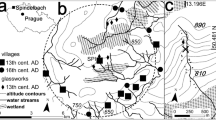Abstract.
The influence of pre-industrial animal husbandry on the boreal forest in south-central Sweden has been studied by pollen and charcoal analyses of peat profiles from two mires in the vicinity of a shieling site. The impact of farming on the local vegetation development is demonstrated from cal. A. D. 1300–1500 in three ways: forest clearance and cultivation of cereals at the local shieling site; alterations of hydrology and vegetation, such as an increase in Cyperaceae, at mires used for hay production; changes in the composition in the surrounding forest, with decreasing proportions of Betula, Picea and boreo-nemoral broadleaved trees and a consequent increase in Pinus, due to grazing and a change of fire regime. Similar alterations to the forest vegetation are noted at other sites in central and northern Sweden during the last thousand years, when the system of using shielings became more widespread. Hence, early animal husbandry is demonstrated to have had a regional impact on the long-term boreal forest development, replacing the original mixed deciduous-coniferous forest with Pinus dominated forest.
Similar content being viewed by others
Author information
Authors and Affiliations
Additional information
Received November 27, 2001 / Accepted June 20, 2002
Correspondence to: Marie Emanuelsson
Rights and permissions
About this article
Cite this article
Segerström, U., Emanuelsson, M. Extensive forest grazing and hay-making on mires – vegetation changes in south-central Sweden due to land use since Medieval times. Veget Hist Archaeobot 11, 181–190 (2002). https://doi.org/10.1007/s003340200021
Issue Date:
DOI: https://doi.org/10.1007/s003340200021




